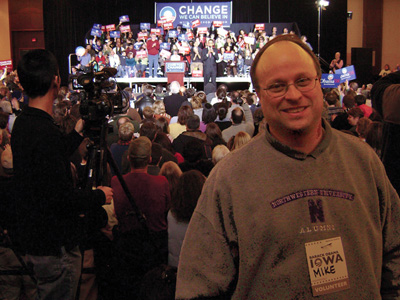The first job President Barack Obama had out of college was community organizer for labor unions and other civic groups on the south side of Chicago.
President Obama used grassroots community organization techniques — Saul Alinsky-style organizing tactics – for union votes, neighborhood improvement and for lobbying city hall in Chicago. Most of these efforts involved “turning people out”: whether at the union hall, the church steps or the polling place. Delivering people to precincts is what David Axelrod, now the president’s chief democratic policy strategist, does best.

At the PRSA 2009 International Conference: Delivering Value, we will reprise these skills and help you learn more about Alinsky and Obama organizing live events. During Monday’s Workshop Set 3 at 10:15 a.m., right after the keynote, we will roll up our sleeves. As I learned at Obama’s Campaign Bootcamp over two years ago, “it is not the parishioners, it is the pastor” who knows more people and can deliver his or her church!
While in Iowa, we were lucky to get 100 college kids at the University of Iowa able come to Candidate Obama’s rallies. They were home for holiday break! However, we could create a groundswell of student activism, and many Iowa kids did come back to the Iowa Caucus vote. In Cedar Rapids, maybe we had 350-500 union workers from the Caterpillar factory — union voters. It was zero degrees with wind chill well below zero. Why not just head home after your shift?
By the time we got to polling day, and the caucuses, Iowans turned out in record numbers. Obama carried the union vote and won the Iowa caucus by wide margins.
In Dallas, Texas, later that campaign season, I helped the advance team as they drew 30,000 people to Reunion Arena. In Virginia, the very last day of the campaign, there were 90,000 people at the local fairgrounds in Manassas — in a scene that reminded us of Woodstock.
Today’s public relations person is still responsible for creating venues and meetings that work. Rallies are important in public affairs. We have had two this year: National Tourism Week, with rallies in Washington, D.C., coordinated by the U.S. Tourism Association, and Alzheimer’s Awareness walks in key cities in our region.
Whether organizing members of your association, folks united in a common issue or cause, or if they are meeting at a convention city like San Diego, you need to show value to your client.
Here are some tips to “turn people out” at your next meeting or event:
- Meet-ups. Belong to meet-up groups. — I use one for association executives that meets for specific nonprofit marketing idea exchange and lead shares. Meet-ups work because people are eager to belong to a community of like-minded individuals.
- Emotional contagion — Strong issues like health care tend to bring people out. For emotionally-driven events, try to emphasize the anecdotes of the attendees.
- Frame the speaker — Try to arrange a small crowd of attendees around the podium, particularly if it is raised above the crowd. That way, photos of the speaker will also imply that the crowd was large. Public relations professionals tend to remember this tactic on platforms and on stages, but not.
- Standing room only — Place the right number of chairs. For smaller community events, put out chairs for about 75 percent of the crowd anticipated. It’s easy to add chairs for more attendees, and it makes the crowd seem larger than anticipated.
- Tweet-ups — Last year at PRSA 2008 International Conference in Detroit, we had a great Tweet-up with Craig Newmark, our client, and the keynote speaker in 2008. (A Tweet-up is an organized online conversation using Twitter.) I also was lucky to meet a new client there. Remember to make one designated hashtag for the event (like #PRSA09) for greater impact and online community-building.
- Twestivals — In Washington, D.C., we had our first charity fund-raiser for Miriam’s Kitchen for the homeless. The event brought in hundreds of Tweeters to raise enough money to fund 10,000 meals — a fifth of their budget — overnight. Similar to a Tweet-up, the event succeeded by sharing the link at the same time, from the same party, on attendees’ Twitter accounts.
- Use latest Web 2.0 tools — reaching reporters, politicians, and other public relations professionals. However, when trying to get people to attend your event, e-mails and phone calls are still the most effective methods of inviting community members, because that is what they use the most.
Approximately 1.8 million Americans attended President Obama’s inauguration — a number that could never have come together without the community organizing we saw throughout the campaign.
 Mike Smith is a Washington insider and beltway native who has deep political connections. He has national campaign and convention experience working for a key Iowa (caucus) newspaper. He also worked for a Gannett newspaper in upstate New York. Smith has a master’s degree in journalism from the Medill School of Journalism at Northwestern University. At the Denver Democratic Convention, he covered tech policy platform issues along with his friend Craig Newmark of Craigslist. Smith also worked as a volunteer on national traveling press and advance for the Obama for President campaign in Iowa, Texas and Virginia. Follow Mike Smith Public Affairs on Twitter at @PRYouReady.
Mike Smith is a Washington insider and beltway native who has deep political connections. He has national campaign and convention experience working for a key Iowa (caucus) newspaper. He also worked for a Gannett newspaper in upstate New York. Smith has a master’s degree in journalism from the Medill School of Journalism at Northwestern University. At the Denver Democratic Convention, he covered tech policy platform issues along with his friend Craig Newmark of Craigslist. Smith also worked as a volunteer on national traveling press and advance for the Obama for President campaign in Iowa, Texas and Virginia. Follow Mike Smith Public Affairs on Twitter at @PRYouReady.
Join Mike for his case study presentation, “Barack Obama: A Case Study in Public Relations and the Citizen’s Campaign,” at the PRSA 2009 International Conference: Delivering Value, November 7–10 in San Diego, CA!






